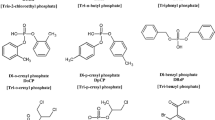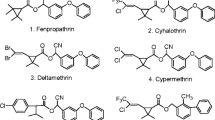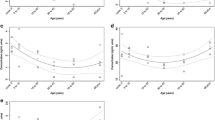Abstract
Pyrethroid insecticides widely used in forestry, agricultural, industrial, and residential applications have potential for human exposure. Short sample preparation time and sensitive, economical high-throughput assays are needed for biomonitoring studies that analyze a large number of samples. An enzyme-linked immunosorbent assay (ELISA) was used for determining 3-phenoxybenzoic acid (3-PBA), a general urinary biomarker of exposure to some pyrethroid insecticides. A mixed-mode solid-phase extraction reduced interferences from acid hydrolyzed urine and gave 110 ± 6% recoveries from spiked samples. The method limit of quantification was 2 μg/L. Urine samples were collected from forestry workers that harvest pine cone seeds where pyrethroid insecticides were applied at ten different orchards. At least four samples for each worker were collected in a 1-week period. The 3-PBA in workers classified as high, low, or no exposure based on job analysis over all sampling days was 6.40 ± 9.60 (n = 200), 5.27 ± 5.39 (n = 52), and 3.56 ± 2.64 ng/mL (n = 34), respectively. Pair-wise comparison of the differences in least squares means of 3-PBA concentrations among groups only showed a significant difference between high and no exposure. Although this difference was not significant when 3-PBA excretion was normalized by creatinine excretion, the general trend was still apparent. No significant differences were observed among days or orchards. This ELISA method using a 96-well plate was performed as a high-throughput tool for analyzing around 300 urine samples measured in triplicate to provide data for workers exposure assessment.


Similar content being viewed by others
References
Meister RT (1996) Farm chemicals handbook ‘96. Meister Publishing Co, Willoughby
Leahey JP (1985) In: Leahey JP (ed) The pyrethroid insecticides. Taylor and Francis, London
Heudorf U, Angerer J (2001) Metabolites of pyrethroid insecticides in urine specimens: current exposure in an urban population in Germany. Environ Health Perspect 109:213–217
Leng G, Leng A, Kühn K-H, Lewalter J, Pauluhn J (1990) Human dose-excretion studies with the pyrethroid insecticide cyfluthrin: urinary metabolite profile following inhalation. Xenobiotica 27:1273–1283
Woollen BH, Marsh JR, Laird WJD, Lesser JE (1992) The metabolism of cypermethrin in man: differences in urinary metabolite profiles following oral and dermal administration. Xenobiotica 22:983–991
Centers for Disease Control and Prevention (2005) Third national report on human exposure to environmental chemicals. Centers for Disease Control, Atlanta
Kolmodin-Hedman B, Akerblom M, Flato S, Alex G (1995) Symptoms in forestry workers handling conifer plants treated with permethrin. Bull Env Contam Toxicol 55:487–493
Lavy TL, Mattice JD, Massey JH, Skulman BW (1993) Measurements of year-long exposure to tree nursery workers using multiple pesticides. Arch Environ Contam Toxicol 24:123–144
Knopp D, Glass S (1991) Biological monitoring of 2,4-dichlorophenoxyacetic acid-exposed workers in agriculture and forestry. Int Arch Occup Environ Health 63:329–333
Frank R, Campbell RA, Sirons GJ (1985) Forestry workers involved in aerial application of 2,4-dichlorophenoxyacetic acid (2,4-D): exposure and urinary excretion. Arch Environ Contam Toxicol 14:427–435
Baker S, Olsson A, Barr D (2004) Isotope dilution high-performance liquid chromatography-tandem mass spectrometry method for quantifying urinary metabolites of synthetic pyrethroid insecticides. Arch Environ Contam Toxicol 46:281–288
Angerer J, Ritter A (1997) Determination of metabolites of pyrethroids in human urine using solid-phase extraction and gas chromatography-mass spectrometry. J Chromatogr B 695:217–226
Harris AS, Lucas AD, Kramer PM, Marco M-P, Gee SJ, Hammock BD (1995) In: Kurtz D, Stanker L, Skerritt J (eds) Frontiers in agrochemical immunoanalysis. AOAC, Washington
Koivunen ME, Gee SJ, Park E-K, Lee K, Schenker MB, Hammock BD (2005) Application of an enzyme-linked immunosorbent assays for the analysis of paraquat in human-exposure samples. Arch Environ Contam Toxicol 48:184–190
Abdel-Rehim M (2004) New trend in sample preparation: on-line microextraction in packed syringe for liquid and gas chromatography applications I. Determination of local anaesthetics in human plasma samples using gas chromatography-mass spectrometry. J Chrom B 801:317–321
Shan G, Huang H, Stoutamire DW, Gee SJ, Leng G, Hammock BD (2004) A sensitive class specific immunoassay for the detection of pyrethroid metabolites in human urine. Chem Res Toxicol 17:218–225
Ahn KC, Lohstroh P, Gee SJ, Gee NA, Lasley B, Hammock BD (2007) High-throughput automated luminescent magnetic particle-based immunoassay to monitor human exposure to pyrethroid insecticides. Anal Chem 79:8883–8890
Rodbard D (1981) In: Langan J, Clapp JJ (eds) Ligand assay: analysis of international developments on isotopic and nonisotopic immunoassay. Masson Publishing Co, New York
Olsson AO, Baker SE, Nguyen JV, Romanoff LC, Udunka SO, Walker RD, Flemmen KL, Barr DB (2004) A liquid chromatography-tandem mass spectrometry multiresidue method for quantification of specific metabolites of organophosphorus pesticides, synthetic pyrethroids, selected herbicides, and deet in human urine. Anal Chem 76:2453–246
Falcó PC, Tortajada Genaro LA, Meseger Lloret S, Blasco Gomez F, Sevillano Cabeza G, Molins Legua C (2001) Creatinine determination in urine samples by batchwise kinetic procedure and flow injection analysis using the Jaffé reaction: chemometric study. Talanta 55:1079–1089
O’Rourke MK, Lizardi PS, Rogan SP, Freeman NC, Aguirre A, Saint CG (2000) Pesticide exposure and creatinine variation among young children. J Exp Anal Env Epi 10:672–681
World Health Organization (1996) Biological monitoring of chemical exposure in the workplace. World Health Organization, Geneva
Barr DB, Wilder LC, Caudill SP, Gonzalez AJ, Needham LL, Pirkle JL (2005) Urinary creatinine concentrations in the U.S. population: implications for urinary biologic monitoring measurements. Env Health Persp 113:192–200
Acknowledgment
We gratefully acknowledge the assistance of Dr. Neil Willits of the Statistics Laboratory at the University of California, Davis. This research was supported in part by the National Institute of Environmental Health Sciences (NIEHS) Superfund Basic Research Program 5P42 ES04699, the NIEHS Center for Children’s Environmental Health & Disease Prevention P01 ES011269, the National Institute of Occupational Safety and Health Western Center for Agricultural Health and Safety 1U50 OH07550, the US Forest Service Pesticide Impact Program, and the Forest Service Region 8 Pesticide Program.
Author information
Authors and Affiliations
Corresponding author
Rights and permissions
About this article
Cite this article
Ahn, K.C., Gee, S.J., Kim, HJ. et al. Immunochemical analysis of 3-phenoxybenzoic acid, a biomarker of forestry worker exposure to pyrethroid insecticides. Anal Bioanal Chem 401, 1285–1293 (2011). https://doi.org/10.1007/s00216-011-5184-z
Received:
Revised:
Accepted:
Published:
Issue Date:
DOI: https://doi.org/10.1007/s00216-011-5184-z




